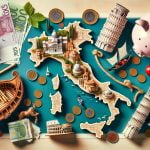Italy, with its rich history, stunning landscapes, and delectable cuisine, is a dream destination for many travelers. However, the question that often lingers in people’s minds is: Is it expensive to travel in Italy? From exploring the cobblestone streets of Rome to savoring gelato in Florence and cruising along the picturesque Amalfi Coast, the cost of traveling in Italy can vary depending on various factors.
Planning and managing expenses are essential when embarking on an Italian adventure. In this article, we will delve into budgeting tips to help you make the most of your trip without breaking the bank. Whether you’re looking for affordable accommodation options, navigating transportation costs, indulging in authentic Italian cuisine, or finding unique souvenirs while shopping – we’ve got you covered with insider tips and tricks to save money during your travels.
Join us as we explore the enchanting country of Italy through a lens focused on cost-effectiveness. From budget-friendly hostels to luxury hotels, train rides through scenic landscapes to sampling mouthwatering dishes without burning a hole in your pocket – discover how you can enjoy all that Italy has to offer while being conscious of your budget. Let’s unravel the mystery surrounding the expenses of traveling in Italy and uncover hidden gems that won’t break the bank.
Budgeting for Your Italian Adventure
Traveling in Italy can be a dream come true for many, but the question that often lingers in the minds of potential travelers is: is it expensive to travel in Italy? The answer to this question ultimately depends on how you plan and manage your expenses. Here are some tips on budgeting for your Italian adventure to ensure you make the most of your trip without breaking the bank:
- Research and plan ahead: Before embarking on your journey to Italy, take the time to research the costs of accommodations, transportation, dining, activities, and attractions. This will help you set a realistic budget and avoid any unexpected expenses.
- Consider traveling during the off-peak season: Prices for accommodations and flights tend to be lower during the shoulder seasons, which are typically spring and fall. By avoiding peak tourist months, you can save money while still enjoying all that Italy has to offer.
- Opt for budget-friendly accommodations: From cozy hostels to affordable bed and breakfasts, Italy offers a range of lodging options to suit every budget. Consider staying in smaller towns or villages instead of major cities like Rome or Florence to save on accommodation costs.
When it comes to budgeting for your Italian adventure, flexibility is key. By being mindful of your expenses and making smart choices along the way, you can experience all that Italy has to offer without breaking the bank. Remember, creating unforgettable memories doesn’t have to come with a hefty price tag. Traveling in Italy can be as affordable or as luxurious as you make it.
Accommodation Options in Italy
When planning a trip to Italy, one of the key considerations for travelers is accommodation. The good news is that Italy offers a wide range of options to suit every budget, from budget-friendly hostels to luxurious hotels. Whether you are looking to save money or splurge on a memorable stay, there is something for everyone in Italy.
Budget-Friendly Hostels
For budget-conscious travelers, hostels are a popular option in Italy. Hostels offer dormitory-style accommodations with shared facilities, making them an affordable choice for those looking to cut costs on lodging. Many hostels in Italy also provide private rooms for those seeking a bit more privacy without breaking the bank. Staying in hostels not only saves money but also provides an opportunity to meet fellow travelers and exchange travel tips and stories.
Luxury Hotels
On the other end of the spectrum, Italy boasts some of the most luxurious hotels in the world, providing unparalleled comfort and impeccable service. From historic palazzos converted into elegant hotels to modern luxury resorts overlooking breathtaking landscapes, there is no shortage of upscale accommodation options in Italy. While staying at luxury hotels may come with a higher price tag, the experience and amenities offered often justify the cost for travelers seeking indulgence and extravagance during their Italian getaway.
Overall, the cost of accommodation in Italy can vary depending on your preferences and budget constraints. Whether you choose to stay in a budget-friendly hostel or indulge in a luxury hotel experience, there are options available for every type of traveler. By planning ahead and exploring different accommodation choices, you can find the perfect place to stay during your Italian adventure without breaking the bank.
Transportation Costs in Italy
Italy offers a variety of transportation options for travelers to navigate the country, each with its own costs and benefits. One of the most popular and convenient ways to travel within Italy is by train. The Italian train system is well developed, efficient, and connects major cities and regions across the country.
While train tickets can be affordable, especially if booked in advance, prices can vary depending on the class of service and type of train. For example, high-speed trains like Frecciarossa tend to be more expensive than regional trains.
Another common way to get around Italy is by bus. Bus services are available in both urban areas and rural regions, offering an economical option for budget-conscious travelers. Local buses are a great way to explore smaller towns and villages that may not be easily accessible by train. Additionally, long-distance bus companies like FlixBus provide affordable intercity travel options for those looking to save money on transportation costs.
For travelers who prefer more flexibility and independence during their trip, renting a car in Italy is also a popular choice. While renting a car gives you the freedom to explore off-the-beaten-path destinations at your own pace, it can also be more costly due to rental fees, fuel expenses, tolls, and parking charges. However, sharing these costs with travel companions can make renting a car a cost-effective option for exploring Italy’s countryside and remote areas.
| Transportation Option | Cost Range |
|---|---|
| Train | Average ticket prices range from $20-$100 depending on distance and class |
| Bus | Local bus fares start at $1-$3 per ride; Long-distance bus tickets range from $10-$50 or more |
| Rental Car | Daily rental rates vary but typically start from $30-$100 per day excluding additional costs mentioned above |
Dining Out in Italy
Italy is renowned for its delicious cuisine, rich in flavors and history. From pasta to pizza, gelato to wine, Italian food is a major highlight of any trip to this beautiful country. Traveling in Italy offers visitors the opportunity to taste authentic dishes made with fresh, local ingredients. But the question remains: is it expensive to dine out in Italy?
Local Eateries and Street Food
One of the best ways to experience Italian cuisine without spending a fortune is by dining at local trattorias, osterias, and pizzerias. These smaller, family-run establishments often offer traditional dishes at reasonable prices. Additionally, exploring street food options can provide a delicious and budget-friendly alternative. Indulge in arancini (rice balls), panini sandwiches, or supplì (deep-fried rice croquettes) from food stalls and markets for a quick and tasty meal.
Set Menus and Lunch Deals
Many restaurants in Italy offer set menus during lunch hours that include multiple courses at a fixed price. This can be a great way to sample a variety of dishes at a more affordable rate. Look out for “Menu del Giorno” or “Menu Turistico” which are specifically designed for tourists looking for high-quality meals without the hefty price tag. Taking advantage of these lunch deals can help you stick to your budget while still enjoying authentic Italian dining.
Cooking Classes and Food Tours
For those looking to dive deeper into Italian cuisine while keeping costs down, consider taking a cooking class or joining a food tour. Not only will you learn about the culinary traditions of the region, but you’ll also get hands-on experience creating your own dishes.
These experiences often include tastings as well, allowing you to savor local specialties without splurging on expensive restaurant meals every day. Plus, learning how to cook traditional Italian recipes can be a valuable skill that you can take home with you after your trip.
Overall, dining out in Italy can range from budget-friendly options to high-end gourmet experiences depending on where you choose to eat. By exploring local eateries, taking advantage of set menus and lunch deals, and participating in cooking classes or food tours, travelers can enjoy authentic Italian cuisine without breaking the bank.
So, while Italy offers plenty of opportunities for indulging in delectable dishes, it is possible to eat well without spending excessively during your travels in this gastronomic paradise.
Activities and Attractions
Italy is a land filled with rich history, stunning architecture, and breathtaking landscapes, making it a top destination for travelers from around the world. When planning a trip to Italy, it is essential to consider the costs associated with visiting must-see sights and partaking in unique experiences. From iconic landmarks like the Colosseum in Rome to the beautiful canals of Venice, exploring the country’s attractions can be both enriching and pricey.
One of the most popular attractions in Italy is the Vatican City, home to St. Peter’s Basilica and the Sistine Chapel. While entrance to St. Peter’s Basilica is free, there is an admission fee to visit the Vatican Museums and Sistine Chapel.
Ticket prices can vary depending on the time of year and whether you choose a guided tour or opt for a self-guided visit. It is advisable to book tickets in advance to avoid long queues and secure your spot.
Another must-visit sight in Italy is the ancient city of Pompeii, located near Naples. Exploring this archaeological site gives visitors a glimpse into life during Roman times before Mount Vesuvius erupted in 79 AD. The cost of admission to Pompeii is relatively affordable, with discounts available for students, seniors, and EU citizens under 18 or over 65 years old. Guided tours are also available for those looking for a more in-depth experience while exploring this historic site.
| Attraction | Cost |
|---|---|
| Vatican Museums and Sistine Chapel | $20-$30 (prices may vary) |
| Pompeii | €16 (standard ticket), discounts available |
Shopping in Italy
When exploring Italy, shopping for unique souvenirs is a must-do activity to remember your trip. While Italy is known for its high-end designer shops and luxury goods, there are also plenty of opportunities to find budget-friendly items and deals. Here are some tips on finding unique souvenirs and deals while shopping in Italy:
- Visit local markets: One of the best ways to find unique and affordable souvenirs in Italy is by visiting local markets. Markets like Mercato di San Lorenzo in Florence or Campo de’ Fiori in Rome offer a wide variety of items from food products to handmade crafts at reasonable prices.
- Shop off the beaten path: Instead of sticking to touristy areas, venture off the beaten path to discover hidden gems and boutique shops. You’re more likely to find one-of-a-kind items that will remind you of your Italian adventure without the hefty price tag.
- Take advantage of sales and discounts: Keep an eye out for sales and discounts at larger retailers or department stores. Especially during offseasons, many shops offer great deals on clothing, accessories, and other products.
Italy is famous for its artisanal products such as leather goods, ceramics, wine, olive oil, and more. When shopping for souvenirs in Italy, consider investing in quality items that showcase the country’s craftsmanship and traditions. Whether you’re looking for a stylish leather bag from Florence or a hand-painted ceramic piece from Sicily, these unique souvenirs are worth the investment.
: Shopping in Italy can be a delightful experience if you know where to look. By exploring local markets, shopping off the beaten path, taking advantage of sales and discounts, and investing in quality artisanal products, you can find unique souvenirs without breaking the bank. Remember that the true value of these souvenirs lies not only in their physicality but also in the memories they hold from your unforgettable trip to Italy.
Money-Saving Hacks for Traveling in Italy
Traveling in Italy can be a dream come true for many, but concerns about expenses often linger in the minds of potential visitors. The good news is that exploring this beautiful country doesn’t have to break the bank if you plan wisely and utilize some money-saving hacks along the way.
One of the simplest ways to save money while traveling in Italy is to look for accommodations outside of major tourist areas. Opting for smaller towns or villages can not only provide a more authentic experience but also offer cheaper lodging options compared to big cities like Rome or Florence. Additionally, consider staying in hostels or bed-and-breakfasts rather than luxury hotels to cut down on costs without sacrificing comfort.
When it comes to transportation, taking advantage of Italy’s efficient train system can help you save money and time. Investing in a rail pass or booking tickets in advance online often comes with discounts and promotions. Alternatively, consider renting a car for greater flexibility, especially if you plan on exploring off-the-beaten-path destinations. And don’t forget about budget-friendly bus options for shorter distances within cities or regions.
Exploring Italy’s culinary scene is a highlight of any visit, but dining out at fancy restaurants every day can quickly add up. To save money while still indulging in authentic Italian cuisine, opt for local trattorias and family-owned osterias where prices are typically more affordable than trendy eateries targeting tourists.
Also, try eating out during lunch hours when many restaurants offer fixed-price menus that are more budget-friendly than dinner options. With these money-saving tips in mind, traveling in Italy can be an enriching experience without breaking the bank.
Conclusion
When considering the overall cost of traveling in Italy, it’s essential to weigh the various expenses involved in such a trip. While Italy certainly offers premium experiences that can come with a hefty price tag, there are also plenty of ways to explore this beautiful country on a budget. By carefully planning and managing your expenses, you can enjoy everything from charming accommodations to mouth-watering cuisine without breaking the bank.
Accommodation options in Italy range from budget-friendly hostels to luxurious hotels, giving travelers the flexibility to choose what suits their preferences and budget. Transportation costs can vary depending on whether you opt for trains, buses, or car rentals.
While dining out at Italian restaurants is a must-do experience, there are also ways to sample authentic cuisine without overspending. Additionally, activities and attractions in Italy offer a diverse range of options, with some iconic sights requiring entrance fees while others are free to visit.
In conclusion, while traveling in Italy can be costly, it doesn’t necessarily have to break the bank. With careful planning and money-saving hacks, exploring this enchanting country can be both affordable and rewarding. So, is it expensive to travel in Italy? The answer ultimately depends on how you choose to navigate your journey through this captivating destination.
Frequently Asked Questions
Is Italy Expensive for Tourism?
Italy can be considered relatively expensive for tourism compared to some other destinations. Accommodation, dining, and attractions in popular tourist cities like Rome or Venice can come with a hefty price tag. However, there are ways to make your trip more affordable by opting for budget accommodations, eating at local trattorias, and taking advantage of free attractions.
Is It Cheap to Travel in Italy?
Traveling in Italy can vary in cost depending on your preferences and travel style. It is possible to travel cheaply in Italy by choosing budget-friendly options for accommodation, transportation, and food. Traveling during the offseason can also help you save money as prices for hotels and flights tend to be lower.
What Is the Cheapest Time of Year to Go to Italy?
The cheapest time of year to go to Italy is typically during the shoulder seasons of spring (April to June) or fall (September to October). During these months, you can often find lower prices on flights and accommodations since it’s not peak tourist season. Additionally, visiting smaller towns or less crowded areas can help stretch your budget further.

I’m a passionate traveler, writer, and Italophile. My fascination with Italy’s history, art, and culture has led me on countless adventures across the Italian landscape. Through “I Live Italy,” I share my love for this extraordinary country and aims to inspire others to explore its boundless beauty.





